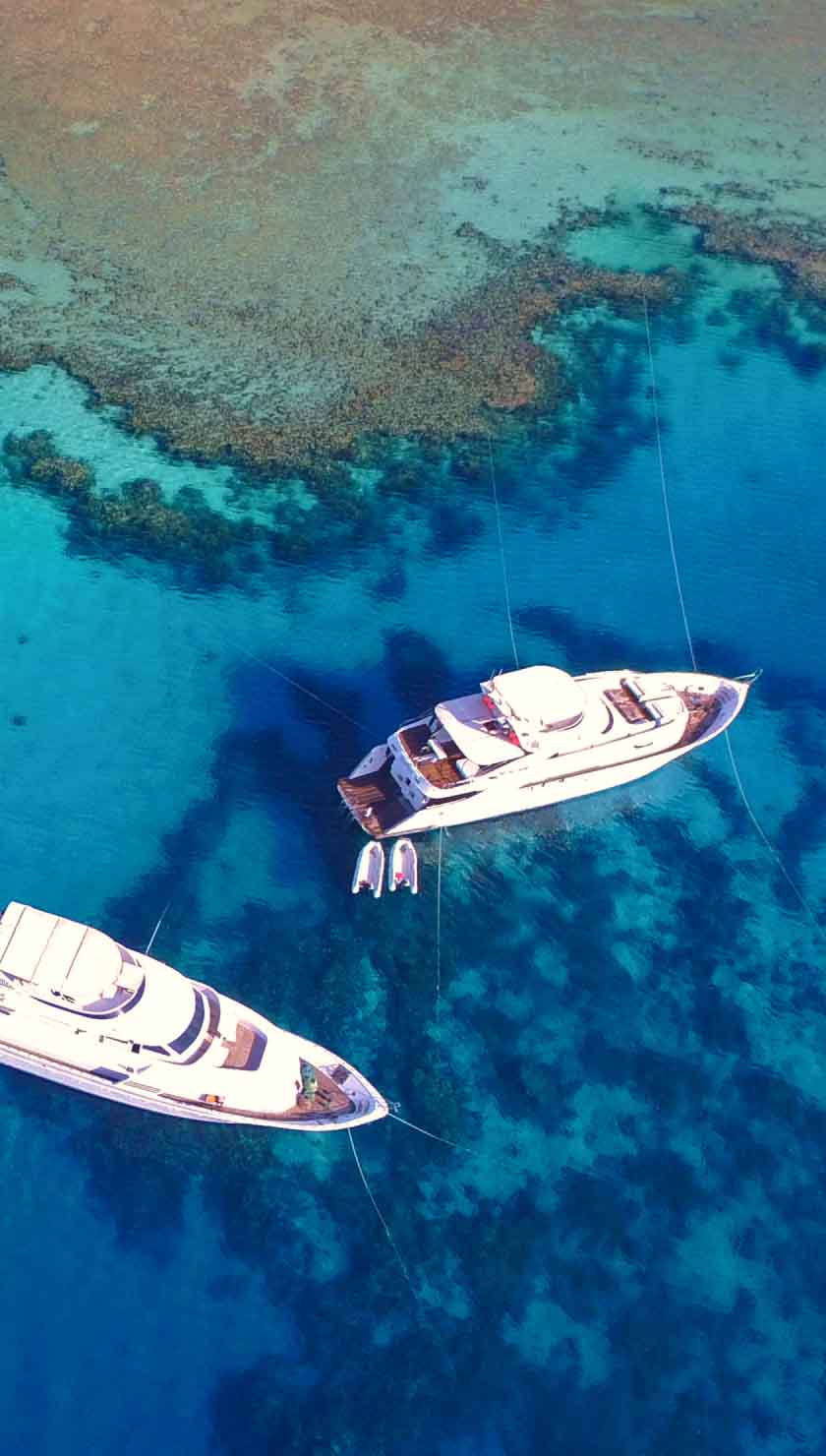Liveaboard diving in Malapascua, a deliciously sleepy island off the north of Cebu, is all about thresher sharks, some of the most graceful and elusive elasmobranchs in the ocean. Malapascua's Monad Shoal is the only location in the world where these special creatures can be reliably seen, along with manta rays and other pelagic wonders. However, beginner divers should know that Monad Shoal sometimes experiences strong currents and that its depth makes a nitrox certification very useful. On land, Malapascua entrances its visitors with a laid-back island vibe stemming from the lack of cars and the profusion of friendly locals. Liveaboards in Malapascua include Sea Doors and the Philippines Siren.
The length of liveaboard itineraries in Malapascua is usually six or ten nights, with a budget of around 300 euros per night. The best time to dive Malapascua is from June to December; visibility during these summer months is at its best, and the water temperature averages a comfortable 27-30 C. Malapascua liveaboards depart from Cebu City, whose international airport receives constant flights from Manila and direct international flights from other Southeast Asian locations. Other destinations visited by Malapascua liveaboards include Cebu, Negros, Leyte, and more.
In-the-know divers herald liveaboard diving in the Visayas as a great way to see the best of the Philippines' underwater scene. Encompassing a group of large and small islands in the central and eastern parts of the country, the Visayas offers premier macro-life, whale sharks, thresher sharks, swirling masses of sardines, and dive sites beloved for their coral diversity and health. Visayas liveaboard destinations can include Moalboal in Cebu with its massive sardine schools, Apo Island in Negros (the world's model for community-based marine protected areas), volcanic Camiguin, Bohol and Siquijor, and Southern Leyte. Experienced and entry-level divers can all find their niches in Visayas dive sites—liveaboards in the Visayas range from M/V yacht types to refurbished merchant vessels.
The length of liveaboard itineraries in the Visayas is six to ten nights, though select extended itineraries run for twelve or thirteen nights. Budgets range from 250 euros to 500 euros per day. The best time to dive in the Visayas is year-round, though some liveaboards will not run Visayas trips from March to June because they're in Tubbataha. Many Visayas liveaboards depart from Cebu City, whose international airport receives constant flights from Manila and direct international flights from other Southeast Asian locations. However, some Visayas liveaboards depart or land at Moalboal (reachable by road from Cebu City), Malapascua (reachable by road/ferry from Cebu City), or Dumaguete (reachable by domestic flight from Manila or flight/road/ferry from Cebu City).
Liveaboard diving in Tubbataha Reef National Park tops the wish list of many divers due to its designation as a World Heritage Site and its reputation as one of the best dive areas in the world. The remote Sulu Sea atolls of this national marine park are only accessible by liveaboard, and making the trip to see them rewards divers with a healthy mix of hammerhead sharks and pelagic life, plenty of turtles, dramatic underwater landscapes, and pristine coral, plus an overflowing of incredible macro life that only the Philippines can offer. Tubbataha dive sites at the North and South Atolls and Jessie Beazley Reef are for experienced divers who can handle currents and appreciate the diversity of marine life. However, conservation does not end underwater at Tubbataha; the atolls are also a bird sanctuary. Liveaboards in Tubbataha range from M/V yacht types to refurbished merchant vessels.
Apo Island snorkeling is considered to be some of the best in the world, and it has become world famous for the biologically vibrant 225,000 square meters marine habitat full of pristine corals and countless marine species, including sea turtles, clownfish, lionfish, parrotfish, Moray eels and, if you're lucky, maybe even a whale shark.
The length of liveaboard itineraries in Tubbataha is usually six or seven nights, and trips run from March to June for ideal visibility and calm seas. The budget for a Tubbataha liveaboard can range from 300 to over 500 euros per night. Most liveaboards depart from the port of Puerto Princesa in Palawan, which a 1.5-hour flight from Manila can reach. However, Seadoors and Philippine Siren offer a few extended itineraries that combine Tubbataha with the Visayas and depart or land in the Visayas region.
More about diving in the Philippines
- Marvel at the conservation success of fish-filled Apo Island, one of the world's first community-based marine protected areas.
- Float over Balicasag Island's dancing fish and an explosion of colorful coral- and don't miss the crowds of green turtles in the seagrass.
- Dive Dauin to hunt for wonderpus, flamboyant cuttlefish, frogfish, and seahorses.
- Hop from Mactan to Olango Island for whitetip sharks, barracuda, and other pelagics, including an occasional hammerhead.
- Take your pick from Mactan's coral gardens, wrecks, walls, and caverns.
Best Time to Travel
Philippines diving season is all year round, but there are distinct seasons that affect dive conditions, such as during typhoons in the months of September to December. The dry season from March to June is usually when the water is warmest and the visibility best, making it the best time to dive in the Philippines. Water temperature in the Philippines during dives vary at around 23-30 C / 73-86 F depending on the season. Visibility ranges from around 5-45 meters/16-148 feet but carries strong seasonal and local variability. Certain marine wildlife also appears during particular months, such as the whale shark, which appears around March to May, and premier dive spots, such as Tubbataha Reef, are best dived during the seasons of March to June when visibility is best.
Ports of departure and how to get there
The departure location for most Visayas liveaboards (including Malapascua) is Cebu City, a booming metropolis and regional capital. From the port of Cebu City, liveaboards set off for Apo Island, Moalboal, Siquijor, Bohol, Camiguin, Leyte, and of course, Malapascua. Select Visayas itineraries also use Malapascua, Moalboal, Dumaguete, or (rarely) Puerto Princesa as a departure/arrival port (see Visayas section above). Visitors with extra time in Cebu City can either enjoy some creature comforts (though traffic is bad) or make use of the plentiful ferries and land transport options that take you to other islands or into Cebu's forested interior of jungles and waterfalls. Divers in Cebu City have the reefs of Mactan Island right at their fingertips, where entry-level divers are welcome.
Getting to Cebu City is easy with a 1.5-hour flight from Manila. Cebu City International Airport also receives direct flights from select Southeast Asian countries nearby and some international flights via transfers in neighboring regional countries.
Puerto Princesa, Palawan's capital city, is the departure location for most Tubbataha liveaboards. Visitors with some extra time here can take their pick from premier land and sea activities near Puerto Princesa, including island-hopping, jungle explorations, and Palawan's other World Heritage Site- the Puerto Princesa Underground River. Puerto Princesa is only a van ride away from many dive sites with 100% coral cover in areas like Port Barton and the famous El Nido. Entry-level divers in Palawan can enjoy these sites, many of which are shallow reef slopes in protected bays.
Flights to Puerto Princesa run regularly from both Manila and Cebu City. Travelers can choose between Cebu Pacific and Philippines Airlines. To get to Manila or Cebu City, direct flights are available from many Southeast Asian countries. International flights will usually transfer to the region before flying into the Philippines.











